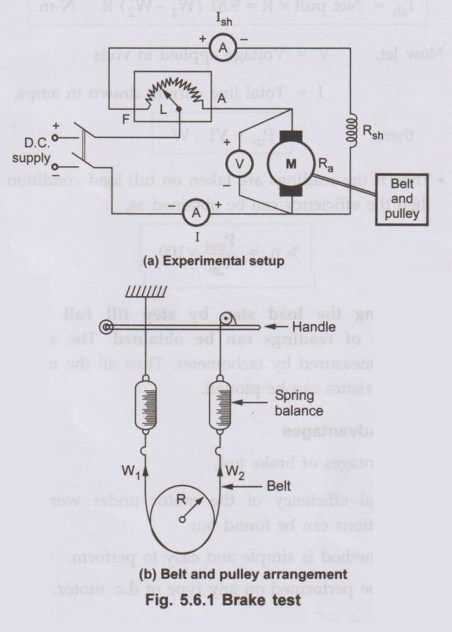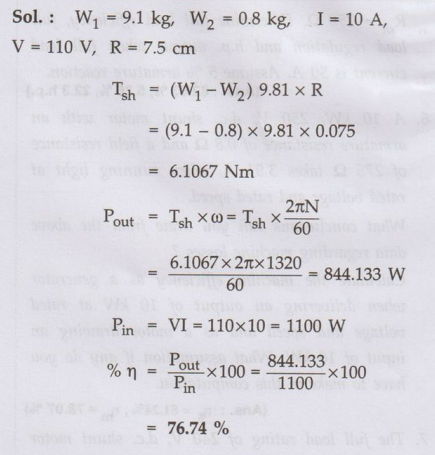Electrical Machines: Unit III: b.Testing of D.C. Machines
Brake Test
Advantages, Disadvantages, Solved Example Problems | Testing of D.C. Machines
Another method of testing the d.c. motor is brake test method. This is a direct method of testing the motor. In this method, the motor is put on the direct load by means of a belt and pulley arrangement.
Brake
Test
AU: Dec.-07
•
Another method of testing the d.c. motor is brake test method. This is a direct
method of testing the motor. In this method, the motor is put on the direct
load by means of a belt and pulley arrangement. By adjusting the tension of
belt, the load is adjusted to give the various values of currents. The load is
finally adjusted to get full load current. The power developed gets wasted
against the friction between belt and shaft. Due to the braking action of belt
the test is called brake test.
The
Fig. 5.6.1 (a) shows the experiemental setup for performing brake test on a
d.c. shunt motor while the Fig. 5.6.1 (b) shows the belt and pulley arrangement
mounted on the shaft of the motor.

•
The tension in the belt can be adjusted using the handle. The tension in kg can
be obtained from the spring balance readings.
Let
R = Radius of pulley in metre
N
= Speed in r.p.m.
W1 = Spring balance reading on tight side in kg
W2
= Spring balance reading on slack side in kg.
• So net pull on the belt due to friction at
the pulley is the difference between the two spring balance readings.
Net
pull = W1- W2 kg = 9.81 (W1-W2) N
•
As radius R and speed N are known, the shaft torque developed can be obtained
as,
Tsh
= Net pull x R = 9.81 (W1-W2) R N-m
Hence
the output power can be obtained as,
Tsh
= Net pull x R = 9.81 (W1 - W2) R N-m
Now
let, V = Voltage applied in volts
I
= Total line current drawn in amps.
Then
Pin = VI W
•
Thus if the readings are taken on full load condition then the efficiency can
be obtained as,
%
η = Pout / Pin × 100
•
Adjusting the load step by step till full load, number of readings can be
obtained. The speed can be measured by tachometer. Thus all the motor
characteristics can be plotted.
1. Advantages
The
advantages of brake test,
1.
Actual efficiency of the motor under working conditions can be found out.
2.
The method is simple and easy to perform.
3.
Can be performed on any type of d.c. motor.
2. Disadvantages
The
disadvantages of brake test,
1.
Due to friction, heat is generated and hence there is large dissipation of
energy.
2.
Some type of cooling arrangement is necessary.
3.Convenient only for small machines due to
limitations regarding heat dissipation arrangements.
4.
The power developed gets wasted hence method is expensive.bit of
5.
The efficiency observed is on lower side.
Ex. 5.6.1
In a brake test conducted on a d.c. shunt
motor the full load readings are observed as, Tension on tight side 9.1 kg,
Tension on slack side = 0.8 kg, Total current = 10 A. Supply voltage = 110 V,
Speed = 1320 r.p.m., The radius of the pulley is 7.5 Cm. Calcualte its full
load efficiency.
Sol. :

Review Questions
1. Explain how to
obtain efficiency of a d.c. machine by conducting brake test. State its
advantages and disadvantages.
2. What precaution is
necessary to be observed while performing brake test on a d.c. series motor? AU: Dec.-07, Marks 3
Electrical Machines: Unit III: b.Testing of D.C. Machines : Tag: : Advantages, Disadvantages, Solved Example Problems | Testing of D.C. Machines - Brake Test
Related Topics
Related Subjects
Electrical Machines I
EE3303 EM 1 3rd Semester EEE Dept | 2021 Regulation | 3rd Semester EEE Dept 2021 Regulation
